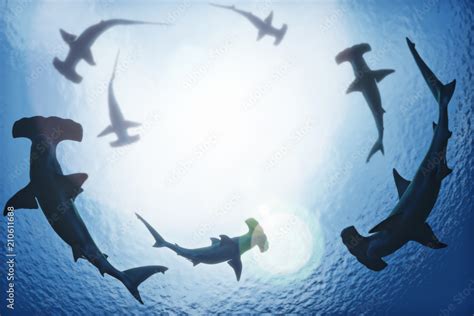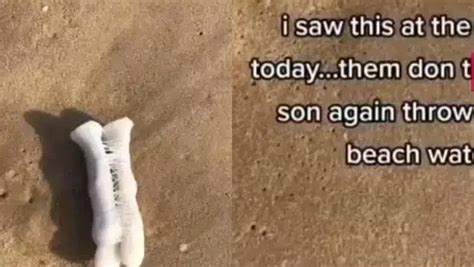
A hammerhead shark unexpectedly plummeted from the sky onto a South Carolina disc golf course on Wednesday, stunning players and wildlife officials alike. The juvenile shark, discovered near the ninth green at the Charleston County Park’s disc golf course, was already deceased, leaving authorities to investigate the bizarre incident.
Charleston County Parks Police are currently investigating how the shark ended up so far from the ocean. According to the Charleston County Park & Recreation Commission (CCPRC), “A hammerhead shark, approximately 4-5 feet in length, was found on a disc golf course within a Charleston County Park on Wednesday.”
Speculation abounds regarding the cause of the incident, with the leading theory suggesting a large bird of prey, such as an osprey, may have dropped the shark mid-flight.
Further investigation is underway to determine the exact circumstances surrounding the unusual event.
The discovery of the shark immediately sparked curiosity and concern among park visitors and online communities. The CCPRC confirmed the incident and assured the public that an investigation is ongoing. “We’re still looking into how it happened,” said a CCPRC spokesperson.
Hammerhead sharks are common in the coastal waters off South Carolina. However, finding one inland and deceased raises numerous questions. Authorities are examining the shark for any signs of injury that might shed light on its cause of death or how it ended up on the disc golf course.
The incident highlights the complex interactions within the coastal ecosystem and the potential for unusual occurrences that can captivate public attention. Park officials are working to provide a clear explanation for the event while ensuring the safety and well-being of park visitors.
Detailed Examination of the Incident
The discovery of the hammerhead shark occurred on Wednesday morning, surprising disc golf players as they navigated the course. The shark, estimated to be between four and five feet long, was found some distance from any body of water, prompting immediate speculation about how it arrived at the location.
Park rangers secured the area and contacted relevant authorities, including wildlife officials and marine biologists, to assist in the investigation. The shark was carefully examined for any visible injuries or signs of trauma that might indicate the cause of death.
Preliminary findings suggest that the shark may have been carried inland by a large bird, though other possibilities are also being considered. The distance from the ocean to the disc golf course makes it unlikely that the shark swam there on its own.
“It’s certainly an unusual situation,” said Dr. Emily Greenway, a local marine biologist who was consulted on the case. “Hammerhead sharks are typically found in coastal waters, and it’s rare for them to venture so far inland.”
The Charleston County Parks Police are working to gather additional information, including interviewing park visitors and reviewing any available surveillance footage, to piece together the events leading up to the discovery of the shark.
Potential Explanations and Theories
Several theories have emerged to explain how the hammerhead shark ended up on the disc golf course. The most plausible explanation involves a large bird of prey, such as an osprey or eagle, which are known to hunt fish and other marine creatures.
Ospreys, in particular, are skilled hunters that can carry relatively large prey over considerable distances. It is conceivable that an osprey caught the shark in the ocean and was transporting it to a nesting site when the shark was accidentally dropped.
“Ospreys are common in this area, and they are certainly capable of catching and carrying a shark of this size,” said Greenway. “It’s possible that the bird lost its grip on the shark, or that the shark was too heavy to carry for a long distance.”
Another theory suggests that the shark may have been caught in a fishing net and subsequently discarded inland. However, this scenario seems less likely given the absence of any obvious signs of entanglement or injury.
A third possibility is that the shark was transported to the area by a person, either intentionally or unintentionally. However, authorities have found no evidence to support this theory, and it is considered less probable than the bird-of-prey explanation.
“We are keeping all options open at this point,” said a spokesperson for the Charleston County Parks Police. “We are conducting a thorough investigation to determine the most likely cause of this incident.”
Impact on the Local Ecosystem
The unusual discovery of the hammerhead shark raises questions about the health and stability of the local coastal ecosystem. While the incident appears to be an isolated event, it underscores the interconnectedness of marine and terrestrial environments.
Hammerhead sharks play an important role in the marine food web, preying on fish, crustaceans, and other invertebrates. Their presence helps to regulate populations and maintain the overall balance of the ecosystem.
The removal of even a single shark from the ecosystem can have cascading effects, potentially impacting other species and habitats. In this case, the loss of the juvenile hammerhead shark is unlikely to have a significant impact on the overall population, but it serves as a reminder of the importance of protecting marine life.
“We need to be mindful of the impact that human activities can have on marine ecosystems,” said Greenway. “Pollution, overfishing, and habitat destruction can all threaten the health and survival of sharks and other marine species.”
The Charleston County Park & Recreation Commission is committed to protecting the natural resources within its parks and is working to educate visitors about the importance of conservation.
Community Reactions and Social Media Buzz
The discovery of the hammerhead shark on the disc golf course has generated considerable interest and discussion within the local community and on social media. Many people have expressed surprise and disbelief at the unusual event, while others have offered their own theories and explanations.
The incident has also sparked a broader conversation about the importance of wildlife conservation and the need to protect marine ecosystems. Many people have used social media to share information about hammerhead sharks and the threats they face, such as overfishing and habitat loss.
“It’s amazing how quickly this story has spread,” said a local resident who regularly visits the park. “It just goes to show how much people care about wildlife and the environment.”
The Charleston County Park & Recreation Commission has been actively engaging with the public on social media, providing updates on the investigation and answering questions about the incident. The commission has also used the opportunity to educate people about the local ecosystem and the importance of responsible recreation.
“We appreciate the public’s interest in this unusual event,” said a spokesperson for the CCPRC. “We are committed to providing accurate information and promoting responsible stewardship of our natural resources.”
Hammerhead Sharks: An Overview
Hammerhead sharks belong to the family Sphyrnidae and are characterized by their distinctive hammer-shaped heads, known as cephalofoils. These unique structures are believed to enhance their sensory capabilities, allowing them to better detect prey and navigate their environment.
There are nine known species of hammerhead sharks, ranging in size from the dwarf hammerhead, which is only about 3 feet long, to the great hammerhead, which can reach lengths of up to 20 feet. Hammerhead sharks are found in tropical and temperate waters around the world, including the coastal waters off South Carolina.
These sharks are active predators, feeding on a variety of prey, including fish, crustaceans, and cephalopods. They use their hammer-shaped heads to pin down prey against the seafloor, making it easier to capture and consume.
Hammerhead sharks are generally considered to be harmless to humans, although they are capable of inflicting a bite if provoked. There have been very few documented cases of hammerhead sharks attacking humans.
However, many species of hammerhead sharks are facing increasing threats from overfishing, habitat loss, and pollution. Several species are listed as endangered or vulnerable by the International Union for Conservation of Nature (IUCN).
Conservation efforts are underway to protect hammerhead sharks and their habitats, including regulations on fishing and the establishment of marine protected areas.
The Role of Ospreys in Coastal Ecosystems
Ospreys, also known as sea hawks or fish eagles, are large birds of prey that are commonly found in coastal areas and near bodies of water. They are highly skilled hunters, specializing in catching fish and other aquatic creatures.
Ospreys have several adaptations that make them well-suited for their aquatic lifestyle. They have long, sharp talons that allow them to grasp slippery fish, and their feet have spicules, or small spines, that provide extra grip.
Ospreys also have a reversible outer toe, which allows them to rotate their toes so that they can grip prey with two toes in front and two toes in back. This gives them a more secure hold on their catch.
Ospreys build large nests, typically in tall trees or on man-made structures such as platforms or utility poles. They often return to the same nest year after year, adding to it over time.
Ospreys play an important role in the coastal ecosystem, helping to regulate fish populations and providing a food source for other animals. They are also an indicator species, meaning that their health and abundance can reflect the overall health of the environment.
Ospreys are protected under the Migratory Bird Treaty Act, which prohibits the killing or harming of these birds or their nests. Conservation efforts are underway to protect osprey habitats and ensure their continued survival.
The Significance of Charleston County Parks
Charleston County Parks play a vital role in preserving natural habitats, providing recreational opportunities, and promoting environmental education within the Charleston area. The parks system includes a diverse range of landscapes, from beaches and marshes to forests and lakes.
The parks offer a variety of activities for visitors, including hiking, biking, swimming, fishing, boating, and camping. They also host numerous events and programs throughout the year, such as concerts, festivals, and educational workshops.
Charleston County Parks are committed to protecting the natural resources within their boundaries and promoting sustainable practices. The parks system has implemented various initiatives to reduce its environmental impact, such as recycling programs, energy conservation measures, and water management strategies.
The parks also play an important role in educating the public about the importance of conservation. They offer interpretive programs, guided tours, and educational exhibits that help visitors learn about the local ecosystem and the challenges it faces.
The Charleston County Park & Recreation Commission is dedicated to providing high-quality recreational experiences while protecting the natural environment for future generations.
The Ongoing Investigation
As of the latest update, the investigation into the hammerhead shark incident is still ongoing. Charleston County Parks Police are continuing to gather information and analyze evidence to determine the most likely cause of the event.
Authorities are working with marine biologists and wildlife experts to assess the shark’s injuries and determine whether they are consistent with a bird-of-prey attack or some other type of trauma. They are also reviewing any available surveillance footage from the park to see if it captures any relevant information.
The investigation is expected to take several more days or weeks to complete, as authorities carefully examine all available evidence and consider all possible explanations.
In the meantime, the Charleston County Park & Recreation Commission is urging park visitors to remain vigilant and report any unusual sightings or incidents to park staff. The commission is also reminding people to respect wildlife and maintain a safe distance from animals.
“We want to ensure the safety and well-being of our park visitors, as well as the protection of our natural resources,” said a spokesperson for the CCPRC. “We appreciate the public’s cooperation and support as we continue to investigate this unusual incident.”
The Future of Coastal Conservation
The hammerhead shark incident serves as a reminder of the importance of coastal conservation efforts and the need to protect marine ecosystems. Coastal areas are facing increasing threats from human activities, such as pollution, development, and overfishing.
These threats can have a devastating impact on marine life, including sharks, fish, seabirds, and other species. Conservation efforts are essential to mitigate these threats and ensure the long-term health and sustainability of coastal ecosystems.
Some of the key strategies for coastal conservation include:
- Reducing pollution: Pollution from land-based sources, such as agriculture, industry, and sewage, can contaminate coastal waters and harm marine life. Efforts to reduce pollution include improving wastewater treatment, promoting sustainable agriculture practices, and reducing the use of plastics.
- Protecting habitats: Coastal habitats, such as mangroves, salt marshes, and seagrass beds, provide essential breeding grounds, nurseries, and feeding areas for many marine species. Protecting these habitats involves establishing protected areas, regulating development, and restoring degraded areas.
- Managing fisheries: Overfishing can deplete fish populations and disrupt the marine food web. Sustainable fisheries management practices, such as setting catch limits, regulating fishing gear, and establishing marine reserves, are essential to ensure the long-term health of fish stocks.
- Addressing climate change: Climate change is causing sea levels to rise, ocean temperatures to warm, and ocean acidity to increase, all of which can have significant impacts on coastal ecosystems. Efforts to address climate change include reducing greenhouse gas emissions, adapting to the impacts of climate change, and promoting resilience in coastal communities.
- Educating the public: Raising public awareness about the importance of coastal conservation is essential to garnering support for conservation efforts. Education programs, outreach events, and citizen science initiatives can help people learn about the local ecosystem and the challenges it faces.
By working together, governments, organizations, and individuals can make a difference in protecting coastal ecosystems and ensuring their long-term health and sustainability. The strange case of the airborne hammerhead shark serves as an unexpected catalyst for these important conversations.
Frequently Asked Questions (FAQ)
-
How did the hammerhead shark end up on the disc golf course? The leading theory is that a large bird of prey, such as an osprey, caught the shark in the ocean and dropped it while flying over the disc golf course. Other possibilities, though less likely, include the shark being discarded after getting caught in a fishing net or human intervention. The Charleston County Parks Police are currently investigating the incident to determine the exact cause.
-
Was the shark alive when it was found? No, the hammerhead shark was deceased when it was discovered on the disc golf course. The cause of death is still under investigation.
-
Are hammerhead sharks dangerous to humans? Hammerhead sharks are generally considered to be harmless to humans. While they are capable of inflicting a bite if provoked, there have been very few documented cases of hammerhead sharks attacking humans.
-
What is the Charleston County Park & Recreation Commission doing about this incident? The CCPRC is cooperating with the Charleston County Parks Police in the investigation. They are also using the incident as an opportunity to educate the public about wildlife conservation and the importance of protecting marine ecosystems. They have been actively engaging with the public on social media, providing updates on the investigation and answering questions about the incident.
-
What are hammerhead sharks, and why are they important to the ecosystem? Hammerhead sharks are a family of sharks characterized by their distinctive hammer-shaped heads. There are nine known species found in tropical and temperate waters worldwide. They are active predators that feed on a variety of marine life, including fish, crustaceans, and cephalopods. They play a vital role in regulating populations and maintaining the balance of the marine food web. Their presence helps to regulate populations and maintain the overall health of the ecosystem. However, many species of hammerhead sharks are facing increasing threats from overfishing, habitat loss, and pollution.









